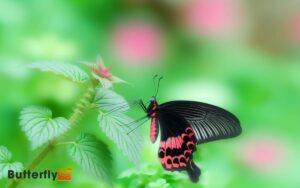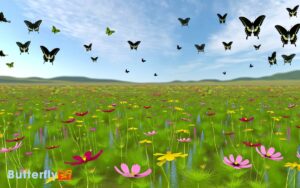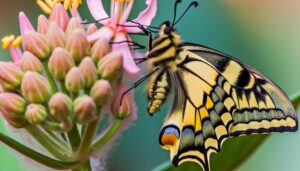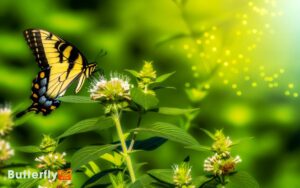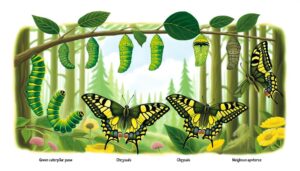Eastern Black Swallowtail Butterfly in Blacksburg Va!
The Eastern Black Swallowtail (Papilio polyxenes) is common in Blacksburg, VA, thriving due to its temperate climate and the abundance of Apiaceae host plants like Daucus carota and Foeniculum vulgare.
Males exhibit vibrant blue and yellow markings, while females have subtler hues. Eggs are laid on parsley and fennel, and caterpillars undergo several instars.
Adults are active from late April to early October, peaking in midsummer. Ideal viewing spots include Huckleberry Trail and Heritage Community Park, where one can observe them nectaring and laying eggs.
For those intrigued by this species’ role in pollination and lifecycle, there’s more to discover.
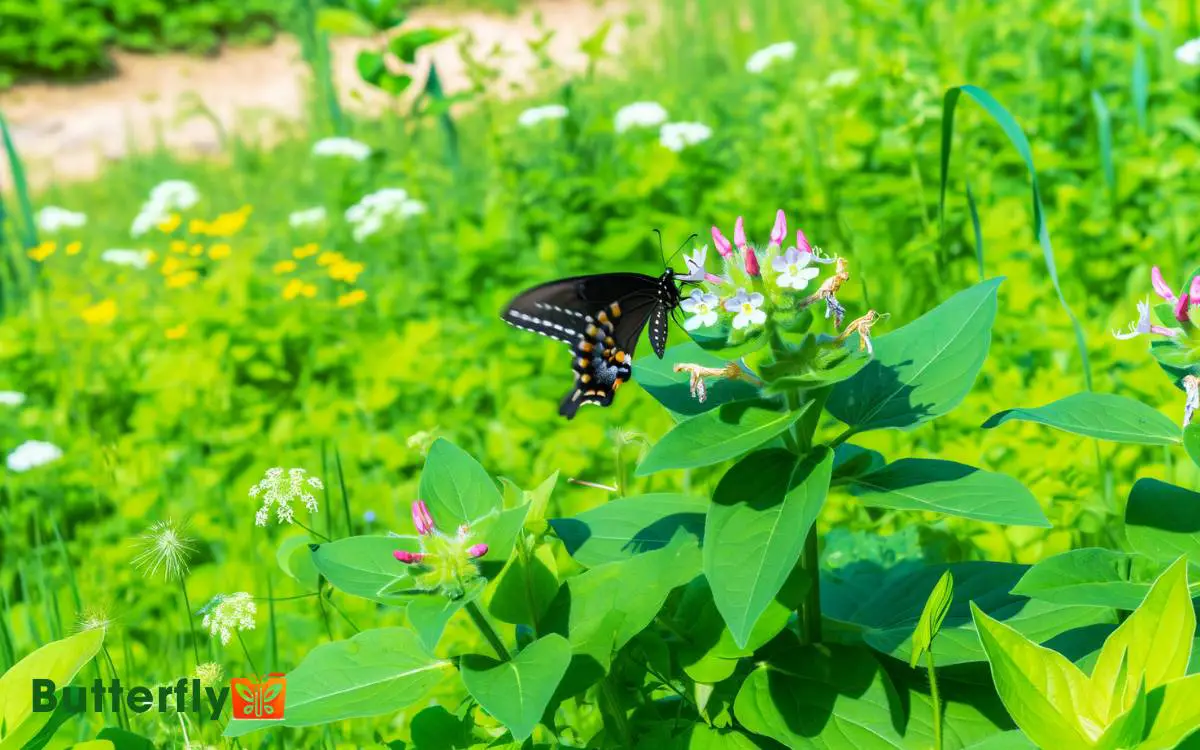
Key Takeaways
Identification and Appearance
The Eastern Black Swallowtail butterfly (Papilio polyxenes) exhibits a mostly black coloration on the dorsal side of its wings, interspersed with orange spots near the body. The ventral side reveals a more intricate pattern, blending shades of black, white, and orange.
Both sexes feature characteristic tails, resembling swallows, hence the name. Males typically display more vibrant blue and yellow markings compared to females, with males possessing a more intense iridescence on their hindwings.
Females, on the other hand, showcase subtler hues, with blue patches on their hindwings being less pronounced.
The males have two rows of yellow spots on the forewings. Their antennae are clubbed, aiding in navigation and sensory perception. These visual cues are crucial for identification within their natural habitats.
Lifecycle and Behavior
The lifecycle of the Eastern Black Swallowtail (Papilio polyxenes) begins when eggs are laid on host plants such as parsley and fennel.
The emerging caterpillars undergo several instars before entering the pupation process, forming a chrysalis. Adult butterflies exhibit behaviors like nectaring on flowers and participating in mating rituals.
Egg to Caterpillar
From the moment Papilio polyxenes lays its tiny, spherical eggs on host plants, the journey from egg to caterpillar begins with intricate biological processes.
These eggs are typically deposited on members of the Apiaceae family, such as Daucus carota (wild carrot) and Pastinaca sativa (wild parsnip).
Within days, embryogenesis occurs, transforming the fertilized egg into a developing larva. Upon hatching, the first instar caterpillars exhibit voracious feeding behavior, consuming the egg shell before feasting on the host plant’s foliage.
This rapid growth demands frequent molting, where the larva sheds its exoskeleton to accommodate its increasing size.
Observers note that these stages, known as instars, are critical for the caterpillar’s eventual metamorphosis into a butterfly.
Pupation Process
Upon reaching the final instar, the caterpillar undergoes significant physiological changes as it prepares for pupation, a stage marked by the formation of the chrysalis where metamorphosis occurs.
The Eastern Black Swallowtail (Papilio polyxenes) larva first finds a secure location, often a stem or a leaf. It spins a silk girdle to anchor itself. The caterpillar then molts one last time, revealing the chrysalis beneath its skin.
This structure, known as the pupal case, hardens and camouflages to blend with its surroundings, offering protection.
Inside the chrysalis, the larva’s tissues break down into a nutrient-rich soup, which will be reorganized into adult structures. This intricate process exemplifies nature’s transformative power, allowing for eventual emergence as a butterfly.
Adult Butterfly Activities
Adult Eastern Black Swallowtails (Papilio polyxenes) engage in various activities critical to their lifecycle, including feeding on nectar, mating, and oviposition on host plants.
They primarily feed on nectar from flowers like Asclepias spp. and Echinacea spp., using their proboscis to extract the nutrient-rich liquid.
Mating involves intricate courtship displays where males patrol territories and engage in aerial chases. Females selectively oviposit on Apiaceae family plants, such as Daucus carota and Pastinaca sativa, ensuring larval access to essential nutrients.
Post-mating, females exhibit oviposition behavior, laying eggs on the underside of leaves. Observing these activities reveals the butterfly’s dependence on specific plant species, highlighting the complexity and precision of their lifecycle and behavioral patterns.
Habitat Preferences
Papilio polyxenes prefers habitats rich in Apiaceae family plants, such as Daucus carota and Foeniculum vulgare.
Ideal climate conditions include temperate zones with moderate humidity and abundant sunlight.
For nesting and breeding, females select sheltered areas with ample host plants for oviposition and larval development.
Preferred Plant Species
Why do the Eastern Black Swallowtail butterflies (Papilio polyxenes) favor particular plant species like Apiaceae family members, such as dill (Anethum graveolens) and fennel (Foeniculum vulgare), for oviposition and larval development?
These plants produce secondary metabolites, particularly furanocoumarins, which caterpillars sequester to deter predators. Additionally, these species provide ideal nutrition, aiding rapid larval growth and successful metamorphosis.
The aromatic compounds in Apiaceae attract gravid females, ensuring a suitable environment for egg-laying. Moreover, the structural complexity of these plants offers effective camouflage, reducing predation risks for larvae.
Such selective oviposition behavior underscores a co-evolutionary relationship, where both plant and butterfly species mutually benefit, enhancing the survival and proliferation of Papilio polyxenes in their ecological niche.
Ideal Climate Conditions
The Eastern Black Swallowtail butterfly thrives in temperate climates characterized by warm summers and mild winters, particularly favoring regions like Blacksburg, VA, where these conditions support their life cycle stages.
Papilio polyxenes exhibits a preference for habitats with well-drained soil and abundant sunlight, ensuring ideal thermoregulation and nectar availability.
Temperature ranges from 20°C to 30°C during summer months are perfect for larval development and adult activity. Relative humidity levels between 50% and 70% prevent desiccation and support egg viability.
Seasonal variations in Blacksburg provide sufficient diapause cues for overwintering pupae, enabling synchronization with host plant (Apiaceae species) phenology.
These climatic factors collectively foster robust populations, facilitating the butterfly’s ecological resilience and freedom to flourish across varied landscapes.
Nesting and Breeding Areas
Eastern Black Swallowtails exhibit a marked preference for nesting and breeding in areas abundant with host plants such as dill, parsley, and fennel, which are critical for larval development.
The species, Papilio polyxenes, is particularly drawn to open fields and gardens where these plants flourish. Their habitat selection guarantees that larvae have immediate access to necessary nutrients.
Observations in Blacksburg, VA, indicate that these butterflies prefer sunny locations with minimal pesticide exposure. They lay eggs on the underside of leaves, ensuring camouflage from predators. The larvae that hatch from these eggs feed on host plants, gradually growing through several instar stages before forming a chrysalis. Similar behaviors have been documented among black swallowtail butterflies in Ohio, where they also seek out pesticide-free environments to thrive. These butterflies play a crucial role in pollination, contributing to the health of local ecosystems.
| Habitat Feature | Preference |
|---|---|
| Host Plants | Dill (Anethum graveolens), Parsley (Petroselinum crispum), Fennel (Foeniculum vulgare) |
| Sunlight Exposure | High |
| Pesticide Presence | Low |
| Nesting Location | Underside of leaves |
| Common Areas | Open fields, gardens |
Their strategic selection of habitat points to an evolved adaptability to human-altered environments.
Role in Pollination
Although often overlooked, Papilio polyxenes play an important role in pollination within the Blacksburg, VA ecosystem.
These butterflies exhibit a preference for Apiaceae family plants, such as Daucus carota and Foeniculum vulgare, aiding in their cross-pollination. Their proboscis, adapted for nectar extraction, facilitates pollen transfer as they forage.
The Eastern Black Swallowtail visits a variety of flowers, including Asclepias syriaca and Echinacea purpurea, ensuring genetic diversity among plant species.
Observations indicate frequent visits to both wild and cultivated flora, enhancing local biodiversity. By acting as vectors, they contribute significantly to the reproductive success of many angiosperms.
Therefore, Papilio polyxenes’ pollination activities are integral to maintaining a balanced and thriving ecosystem in Blacksburg.
Seasonality and Timing
Understanding Papilio polyxenes’ pollination activities necessitates examining their seasonality and timing within the Blacksburg, VA region.
The adult Eastern Black Swallowtail typically emerges from pupae starting in late April, signaling the onset of their active period.
Their flight period extends through early October, encompassing multiple generations due to their capacity for rapid life cycles.
Observations indicate peak activity during mid-summer months, particularly July and August. During this time, adults engage in mating and oviposition, laying eggs on host plants.
The synchrony between butterfly emergence and the blooming period of local flora ensures ideal conditions for pollination.
Monitoring these temporal patterns is essential for understanding their ecological role and supporting conservation efforts in the region.
Local Flora and Host Plants
Throughout the region, Papilio polyxenes relies heavily on specific host plants, particularly members of the Apiaceae family such as Daucus carota and Pastinaca sativa, for oviposition and larval development.
These plants provide essential nutrients required by larvae to metamorphose successfully. Observations indicate a strong preference for cultivated garden environments where these plants thrive.
The availability of these host plants directly influences the population dynamics of this butterfly species.
The following table illustrates key local flora that support Papilio polyxenes:
| Common Name | Scientific Name |
|---|---|
| Wild Carrot | Daucus carota |
| Parsnip | Pastinaca sativa |
| Queen Anne’s Lace | Daucus carota var. carota |
| Fennel | Foeniculum vulgare |
| Dill | Anethum graveolens |
These plants are essential for the butterfly’s lifecycle and contribute to the region’s biodiversity.
Conservation Efforts
To safeguard the survival of Papilio polyxenes, conservation efforts in Blacksburg, VA focus on habitat preservation and the cultivation of host plants like Daucus carota and Foeniculum vulgare.
These efforts aim to create ideal environments for the Eastern Black Swallowtail’s lifecycle.
Key strategies include:
- Habitat Restoration: Restoring native plant communities to support butterfly populations.
- Educational Outreach: Informing the public about the importance of host plants and butterfly conservation.
- Research and Monitoring: Conducting scientific studies to track butterfly populations and assess the effectiveness of conservation measures.
Viewing Spots in Blacksburg
Blacksburg offers several ideal viewing spots for observing the Eastern Black Swallowtail. Particularly around the Huckleberry Trail and Heritage Community Park, where host plants like Daucus carota thrive.
These areas provide crucial habitat, featuring abundant nectar sources and larval host plants such as Pastinaca sativa and Petroselinum crispum.
Observers can frequently spot Papilio polyxenes engaging in oviposition on these plants. The trail’s diverse flora, including Zizia aurea and Foeniculum vulgare, supports both adult and larval stages.
In the morning, the butterflies are often seen basking on sunlit leaves, while afternoons reveal their energetic foraging behavior.
For an excellent viewing experience, visitors should bring binoculars and a field guide to enhance identification accuracy.
Conclusion
To sum up, the Eastern Black Swallowtail (Papilio polyxenes) thrives in Blacksburg, VA, defying urban sprawl and human negligence.
Despite its significant role in pollination, it seems the butterfly’s beauty is more appreciated on Instagram than in conservation efforts.
Perhaps when Papilio polyxenes starts trending, we’ll finally see more than just fleeting admiration. Until then, they’ll continue their lifecycle, undeterred by our obliviousness, fluttering through habitats we barely notice yet critically affect.

